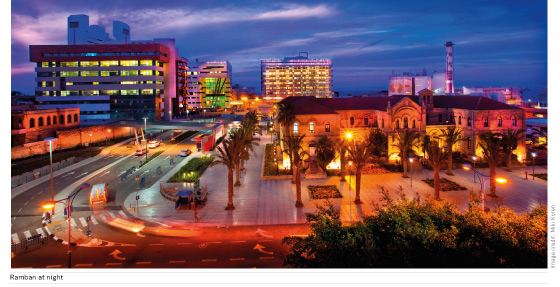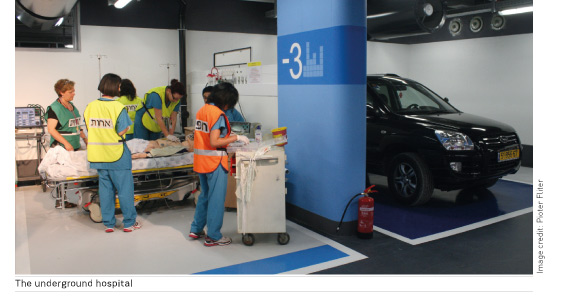HealthManagement, Volume 16 - Issue 4, 2016
RAMBAM HEALTH CARE CAMPUS

The philosophy at Rambam Health Care is medicine, technology and humanity intertwined. Please explain.
Rambam is a very uniquely positioned hospital. It started in 1938 as a hospital for patients, founded by the British mandatory regime, and has grown to be a major academic hospital that includes the Faculty of Medicine of the Technion-Israel Institute of Technology. It operates its combined and forefront clinical activities side by side with the Technion, focusing on innovation in medicine and biomedical engineering. This gives Rambam a unique opportunity to position services between medicine, research and innovation.
When I came in over ten years ago as the hospital director, I arrived with a very strong background in medicine and engineering. I am Professor of Biomedical Engineering and Medicine at Technion in addition to being a clinical interventional cardiologist. I decided, with my leadership team, that this combination of medicine, technology and humanity would be the major theme of this hospital. We put medicine and technology at the forefront, but also combine what we do with humanity, which is putting the patient at the centre, and treating everybody equally. These are at the centre of our vision.
See Also: Anaesthesiology and Critical Care Medicine
Rambam is opening a new cardiovascular hospital. What will be innovative about it and how will it promote multidisciplinary working?
The new cardiovascular hospital will combine all the different disciplines: clinical areas in all disciplines, preventive medicine, public education, surgery and advanced technology. Cardiology is a discipline which is tightly associated with advanced technology and is one of the pioneer disciplines which developed with medical technology. The concept of this cardiovascular hospital is to include within its building all the disciplines, general and acute care, imaging, surgical, interventional and preventive medicine, so that we work together efficiently with the patient at the centre. The vision is to prevent diseases for the future and at the same time use the most advanced technology and create new technologies to treat the heart. It will be under one roof next to the Technion Faculty of Medicine, which has the most advanced stem cell laboratory in the world, under the leadership of Professor Lior Gepstein, who works shoulder to shoulder with Dr. Shulamit Levenberg from Biomedical Engineering at the Technion. This creates a huge opportunity for a world-leading cardiovascular centre.
Rambam has built an underground hospital. Can you explain the background and what is innovative about it?
The concept of an underground hospital was born during the second Lebanon war in 2006, when we were under threat of continuous missile attack for a full month. We continue to be under such threat unfortunately, and we have to be able to treat our patients safely and protect our staff even in a conflict situation. We visioned and planned a new campus at Rambam that includes several buildings: for paediatrics, for cardiovascular care, for cancer, and for research. The parking lot beneath the campus will be a parking lot during times of peace, and it will be converted to a fortified underground hospital if the need arises. That means everything was designed so that every part of the parking lot can also be used as a hospital. The infrastructure, medical gases, equipment connections and so on are contained within the walls. When needed the patients will be moved downstairs. We have carried out simulations and trained our staff how to react. This facility doesn’t exist anywhere else in the world. This hospital can function as the primary trauma and emergency hospital of northern Israel under all conditions.
What do you see as the most promising technologies in the future to improve the outcomes of cardiovascular heart disease?
It is difficult to predict. Cardiovascular disease is still amongst the highest causes of mortality in the western world. What we have achieved over the last four decades is a revolution in the way we diagnose blockages in the arteries and the way we treat them with stents, from metal stents initially through drug-eluting stents and to the recent development of bioabsorbable stents that will disappear from the body after one year. It revolutionised the way to open blockages for both chronic conditions or during heart attacks. The field of revascularisation, creating new blood flow to the muscle, has really reached optimal care. There will be other developments for this, such as robotics that allows automation for this process, making it more precise. It will change the way we do things, but it is not going to change mortality far beyond what we know.

A major challenge today is to treat electrophysiological problems of the heart and prevent sudden death. We know much more today about how to diagnose and treat arrhythmia, we have more efficient drugs, we can ablate foci of arrhythmia, but there is still a way to go to prevent sudden cardiac deaths. This is an area of very active research. Another major challenge that we face is treating heart failure, when the muscle doesn’t have enough power to pump blood. We need to change the way the muscle acts, add to its power, generate better synchrony or add muscle. There are new very promising drugs in the market, and we have to see how effective they are. There are mechanical devices such as ventricular assist devices, which are becoming smaller and more efficient. There are some ideas about to make new muscle using stem cell technology. There is a huge future for directed stem cell therapy to the heart. Rambam with Technion is going to be a major player in this field. I think this can be a major solution to heart failure. We can hopefully generate new muscle, which is the main challenge when most of the patient muscle is weak or dead.
Also currently undergoing major transformation is treatment for heart valve disease. There will be a revolution in treatment. Today most of the valves are repaired still through surgery. In the future it will move to non-surgical, mechanically oriented engineering solutions to treat leaking or stenotic valves. Finally, we have the challenge of education: how to educate the public not to smoke, to eat healthily, keep cholesterol and other factors controlled. So there are still many challenges ahead of us.
This interview will appear in HealthManagement’s cover story on healthcare without borders. Please comment on how Rambam serves patients outside Israel’s borders.
At Rambam we treat everybody. Rambam reflects the population of Israel—at least 25 percent of the staff are Arab. Everybody walks shoulder to shoulder to save lives—Arabs, and Jews, Christians, Muslim and Druze. We are treating also our neighbours in the region. We treat patients referred by the Palestinian Authority, for example for bone marrow and kidney transplants and other therapies not available locally, and we are always open to save lives. Due to the hostilities in Syria we also treat injured Syrian civilians who come to the border and seek medical help. We have treated at Rambam close to 150 patients from Syria with severe injuries. We are also treating patients from the former Soviet Union. Our visionary concept is that medicine has no borders and we are always fighting for life.
















